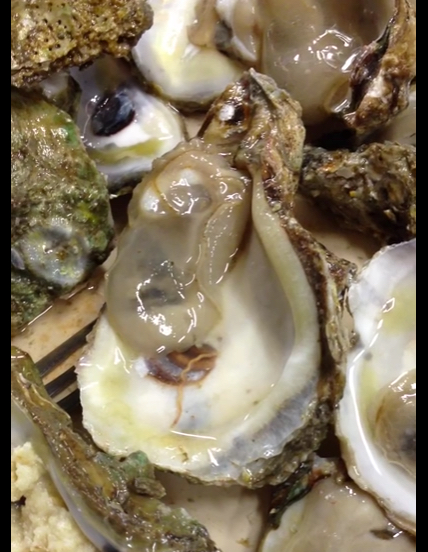At least once a week, a concerned Oyster Obsession member shares the oyster worm video. You have probably seen it. The camera zooms in tight on a plate of raw oysters. The clatter and voices of a busy restaurant fill the background. An oyster fork turns the oyster over in its shell and a man’s voice says, “Right there.” As he uses the fork to point out the small worm, a woman gasps, “Oh my God! What the hell?” and then “The last time I eat oysters. The last time!” The 50-seconds of footage first appeared on YouTube in 2012 and now has millions of plays on Facebook. It’s everything you could ever want in a viral video. It’s food porn. It’s sensational. And it seems to affirm our worst fears about raw food, especially oysters.
That Worm
Here’s the truth about the worm. Yes, finding a worm in your food is about as gross as it gets, but it should make you feel better to know three things:
- The worm doesn’t live in oysters.
- The worm in the video is harmless.
- The worm is there because of bad serving practices and was avoidable.
The worm seen in the video is one of a variety of critters that live in the sediment where oysters live. Since they live in the same place, marine worms are often found in the crevices on the outside of oyster shells. They do not live in oysters.
The worms do not harm the oysters or provide any health risk to consumers. In the past, people considered live marine worms on the oyster shells a sign that the oysters were freshly harvested.
So how did our video-star worm get into that shell? It was bad handling. It rarely happens, but a worm on the outside of an oyster shell can get pushed into the oyster with the shucking knife or fall into the oyster from a dirty shell. That last bit is the key, dirty shells. Oysters should be cleaned before they are shipped and again before they are shucked and plated. When properly scrubbed and rinsed, no mud, sand, or worms remain on the oyster shells.
Finally, you can see the original posting of the infamous video here. And if you still want to give up oysters, it just means there are more for the rest of us!

More About Oyster Cleaning and Oyster Worms
- Annie Lu’s video, “How to Clean Raw/Live Oysters“
- “Removal of Marine Worms from the Surface of Oyster Shells Using Salt Brine” from Prince Edward Island Department of Fisheries, Aquaculture and Environment
- “Oyster Worms” article from the North Carolina Division of Marine Fisheries
- “Worms On Oysters?” A chef’s perspective from Chef Talk.
Oyster Recipes and More…
- What Causes Striped Oyster Shells?
- Can You Really Ignore the R Month Oyster Rule?
- How (and Why) to Read an Oyster Tag
- Search or browse through hundreds of the very best oyster recipes from your favorite magazines, cookbooks, chefs and food blogs. You can find them all (fried, smoked, baked, grilled, sandwiched, stewed, even pickled), right here.
A personal communication back in 2013 from Dr. Sammy Ray, professor emeritus (now deceased), Texas A&M University:
“Tiny wormlike marine annelids, often red or green in color, live naturally in furrows on the oyster
shell. These oyster reef dwellers in no way indicate a lack of wholesomeness, freshness, or sanitation
of the product but are natural constituents of a healthy, productive environment and are common
worldwide. From a food safety standpoint these animals are of no more concern than barnacles
which may also be found on the exterior of the oyster shell.”
Nonetheless, the appearance of a these wormlike critters is alarming and unappetizing. We take a number of steps to clean Nelson’s Bon Secour Oysters, and suggest several control measures for the point of preparation:
(1) Prior to serving, oysters in the shell should be washed free of mud and grit to the fullest
extent possible. Nelson’s Brand Bon Secour Oysters are pre-washed with specially designed
equipment designed to make our shell oysters cleaner than the competition.
(2) Oysters may also be scrubbed by hand, especially at the hinge, to remove any remaining
extraneous material. The hinge of the oyster can harbor small mud and grit particles as well as
these marine annelids. The tap water may warm the exterior of the shell therefore it is
critical to immediately place the oysters back on ice or under refrigeration. They also taste
better when served ice cold!
(3) Before serving, the shell and meat should be inspected for any foreign material including
mud, shell particles – or annelids – which may have been inadvertently pushed onto the oyster
meat during the shucking process. If the oyster is from a sanitary growing area, indicated by a
certified health tag on the container, then any foreign material from the exterior of the shell is
also sanitary and in no way contaminates the oyster but should nonetheless be removed for
aesthetic purposes.
(4) Finally, treat fresh oysters as you would any naturally grown, unprocessed food which
requires additional preparation before serving.
Thank you, Chris! We love Bon Secour Fisheries.